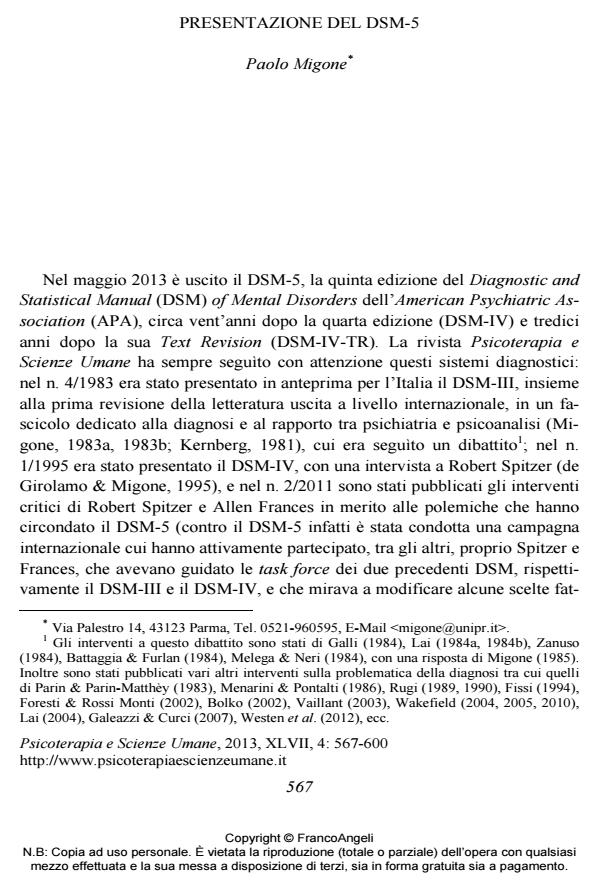Presentation of DSM-5
Journal title PSICOTERAPIA E SCIENZE UMANE
Author/s Paolo Migone
Publishing Year 2013 Issue 2013/4
Language Italian Pages 34 P. 567-600 File size 260 KB
DOI 10.3280/PU2013-004001
DOI is like a bar code for intellectual property: to have more infomation
click here
Below, you can see the article first page
If you want to buy this article in PDF format, you can do it, following the instructions to buy download credits

FrancoAngeli is member of Publishers International Linking Association, Inc (PILA), a not-for-profit association which run the CrossRef service enabling links to and from online scholarly content.
DSM-5, namely the Fifth Edition of the Diagnostic and Statistical Manual (DSM) of Mental Disorders of the American Psychiatric Association (APA) published in May 2013, is presented. After a discussion of five aspects of the DSMs ("atheoretical" approach, polithetic/monothetic, validity/reliability, and categorical/dimensional dichotomies, and multiaxial system - the latter abandoned in DSM-5), the critical debate that surrounded the DSM-5 process is described, and emphasized how lowered diagnostic thresholds might increase "false positive" diagnoses and use of medication. Also some critical comments made by Allen Frances (Chair of the DSM-IV Task Force) are reported. Finally, the DSM-5 structure is described, with some of its main innovations and a detailed illustration of the "Alternative DSM-5 model for personality disorders" which is included in Section III ("Emerging measures and models").
Keywords: DSM-5, psychiatric diagnosis, false positive diagnoses, diagnostic thresholds, dimensional model for personality disorders
- Presentazione della seconda edizione del Manuale Diagnostico Psicodinamico (PDM-2) Paolo Migone, in PSICOTERAPIA E SCIENZE UMANE 2/2018 pp.197
DOI: 10.3280/PU2018-002003 - World Health Organization disability assessment schedule 2.0: An international systematic review Stefano Federici, Marco Bracalenti, Fabio Meloni, Juan V. Luciano, in Disability and Rehabilitation /2017 pp.2347
DOI: 10.1080/09638288.2016.1223177 - Il mondo dell’isteria Adriana Prela, in Ricerca Psicoanalitica /2024
DOI: 10.4081/rp.2024.745 - I disturbi di somatizzazione nel DSM-5 Piero Porcelli, in PSICOTERAPIA E SCIENZE UMANE 3/2014 pp.431
DOI: 10.3280/PU2014-003004 - Validity of the 36-item Persian (Farsi) version of the world health organization disability assessment schedule (WHODAS) 2.0 Sepideh Rajeziesfahani, Stefano Federici, Silvia Bacci, Fabio Meloni, Francesco Bartolucci, Alireza Zahiroddin, Jamal Shams, Simasadat Noorbakhsh, in International Journal of Mental Health /2019 pp.14
DOI: 10.1080/00207411.2019.1568172 - Il processo diagnostico e relazionale in psichiatria. Validità epistemologica tra normalità e patologia Alfio Allò, in Ricerca Psicoanalitica /2021
DOI: 10.4081/rp.2021.277 - Problemi di psicoterapia Paolo Migone, in RUOLO TERAPEUTICO (IL) 127/2014 pp.63
DOI: 10.3280/RT2014-127007 - Toward psychiatry as a ‘human’ science of mind. The case of depressive disorders in DSM-5 Marco Castiglioni, Federico Laudisa, in Frontiers in Psychology /2015
DOI: 10.3389/fpsyg.2014.01517 - Atmosphere and Aesthetics Gianni Francesetti, pp.223 (ISBN:978-3-030-24941-0)
- Considerazioni sulle prospettive della salute mentale in Italia: appunti di lavoro Pietro Pellegrini, in PSICOTERAPIA E SCIENZE UMANE 3/2014 pp.493
DOI: 10.3280/PU2014-003008 - Riusciranno le Linee di indirizzo per il trattamento dei Disturbi Gravi di Personalità a superare la "psichiatria dell'obbedienza giurisprudenziale"? Euro Pozzi, in PSICOTERAPIA E SCIENZE UMANE 3/2014 pp.506
DOI: 10.3280/PU2014-003009 - Outcome Measures and Metrics in Systemic Lupus Erythematosus Behdin Nowrouzi-Kia, Zahi Touma, pp.357 (ISBN:978-3-030-73302-5)
Paolo Migone, Presentazione del DSM-5 in "PSICOTERAPIA E SCIENZE UMANE" 4/2013, pp 567-600, DOI: 10.3280/PU2013-004001